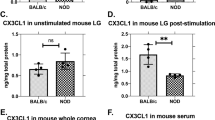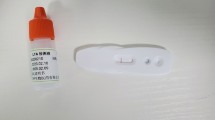Abstract
Purpose
The study was performed to determine whether trefoil factor peptides (TFF) and/or mucins are components of dacryoliths and to gain further insight into dacryolith composition and formation.
Methods
Twenty dacryoliths found in lacrimal surgery in patients suffering from primary acquired nasolacrimal duct obstruction were analyzed for the presence of TFF peptides (TFF1, 2, 3), mucins (MUC1, 2, 3, 4, 5AC, 5B, 6, 7, 8), defense cells (T- and B lymphocytes, macrophages, neutrophils), and antimicrobial substances (alpha defensins 1-3, secretory phospholipase A2) by means of light microscopy, histochemistry, immunohistochemistry, reverse transcription-polymerase chain reaction (RT-PCR) and real-time PCR.
Results
All dacryoliths except one revealed clear immunoreactivity for all three TFF peptides. The immunohistochemical distribution of mucins was inhomogeneous throughout the different dacryoliths. However, in some dacryoliths all mucins investigated were detected. MUC8 showed reactivity in 14 out of 15 dacryoliths analyzed by immunohistochemistry. Most dacryoliths contained alpha defensins 1-3 as the secretory product of neutrophils. T and B lymphocytes, macrophages and secretory phospholipase A2 were only present in single dacryoliths. Quantification of TFF peptide expression supported the immunohistochemical finding that all three TFF peptides are augmented in dacryoliths.
Conclusions
Dacryoliths consist partly of secreted mucins comparable with the mucin spectrum of the epithelium of healthy nasolacrimal ducts. Beside TFF1 and TFF3, both of which are produced under healthy circumstances, TFF2 is additionally induced and secreted in cases of dacryolithiasis. All three TFF peptides appear to be augmented in dacryoliths. With regard to their rheologic properties, TFF peptides may play a functional role in dacryolith formation. However, our results raise the question of whether TFF peptides per se influence dacryolith formation or whether their secretion, as in secretion of mucins and alpha defensins 1-3, is merely a secondary phenomenon.




Similar content being viewed by others
References
Andreou P, Rose GE (2000) Clinical presentation of patients with dacryolithiasis. Ophthalmology 109:1573–1574
Ayub M, Thale A, Hedderich J, Tillmann B, Paulsen F (2003) The cavernous body of the human efferent tear ducts functions in regulation of tear outflow. Invest Ophthalmol Vis Sci. 44:4900–4907
Baratz KH, Bartley GB, Campbell RJ, Garrity JA (1991) An eyelash nidus for dacryoliths of the lacrimal excretory and secretory systems. Am J Ophthalmol 111:624–627
Berlin AJ, Rath R, Rich L (1980) Lacrimal system dacryoliths. Ophthalmic Surg 11:435–436
Duke-Elder S (1952) Textbook of ophthalmology, vol 5: The ocular adnexa. Kimpton, London, p 5364
Gonnering RS, Bosniak SL (1989) Recognition and management of acute noninfectious dacryocystic retention. Ophthal Plast Reconstr Surg 5:27–33
Hauser F, Poulsom R, Chinery R, Rogers LA, Hanby AM, Wright NA, Hoffmann W (1993) hP1.B, a human P-domain peptide homologous with rat intestinal trefoil factor, is expressed also in the ulcer-associated cell lineage and the uterus. Proc Natl Acad Sci USA 90:6961–6965
Hawes MJ (1988) The dacryolithiasis syndrome. Ophthal Plast Reconstr Surg 4:87–90
Herzig S, Hurwitz JJ (1979) Lacrimal sac calculi. Can J Ophthalmol 14:17–20
Jagla W, Wiede A, Dietzmann K, Rutkowski K, Hoffmann W (2000) Co-localization of TFF3 peptide and oxytocin in the human hypothalamus. FASEB J 14:1126–1131
Jones LT (1965) Tear-sac foreign bodies. Am J Ophthalmol 60:111–113
Kominek P, Cervenka S, Doskarova S, Heiderova D, Slabik D, Husek P, Busyska J (2002) Dakryolithiasis – analysis of 15 cases. Cesk Slov Oftalmol 58:205–211
Lew H, Lee S-Y, Yun Y-S (2004) Measurement of pH, electrolytes and electrophoretic studies of tear proteins in tears of patients with dacryoliths: a novel concept for dacryoliths. Ophthalmologica 218:130–135
Linberg JV (2001) Discussion of lacrimal sac dacryoliths. Ophthalmology 108:1312
Orhan M, Onerci M, Dayanir V, Orhan D, Irkec T, Irkec M (1996) Lacrimal sac dacryolith: a study with atomic absorption spectrophotometry and scanning electron microscopy. Eur J Ophthalmol 6:478–480
Paulsen F, Corfield A, Hinz M, Hoffmann W, Schaudig U, Thale AB, Berry M (2003) Characterization of mucins in human lacrimal sac and nasolacrimal duct. Invest Ophthalmol Vis Sci 44:1807–1813
Paulsen F, Hinz M, Schaudig U, Thale AB, Hoffmann W (2002) TFF-Peptides in the human efferent tear ducts. Invest Ophthalmol Vis Sci 43:3359–3364
Paulsen F, Langer G, Hoffmann W, Berry M (2004) Human lacrimal gland mucins. Cell Tissue Res 316:167–177
Paulsen F, Pufe T, Schaudig U, Held-Feindt J, Lehmann J, Schroder JM, Tillmann BN (2001) Detection of natural peptide antibiotics in human nasolacrimal ducts. Invest Ophthalmol Vis Sci 42:2157–2163
Paulsen F, Thale A, Hallmann U, Schaudig U, Tillmann B (2000) The cavernous body of the human efferent tear ducts – function in tear outflow mechanism. Invest Ophthalmol Vis Sci 41:965–970
Paulsen F, Thale A, Kohla G, Schauer R, Rochels R, Parwaresch R, Tillmann B (1998) Functional anatomy of human duct epithelium. Anat Embryol 198:1–12
Paulsen F, Thale A, Maune S, Tillmann B (2001) New insights into the pathophysiology of primary acquired dacryostenosis. Ophthalmology 108:2329–2336
Sasaki M, Ikeda H, Ohira S, Ishikawa A, Nakanuma Y (2004) Expression of trefoil factor family 1, 2, and 3 peptide is augmented in hepatolithiasis. Peptides 25:763–770
Sasaki M, Nakanuma Y, Ho SB, Kim YS (1998) Increased MUC6 apomucin expression is a characteristic of reactive biliary epithelium in chronic viral hepatitis. J Pathol 185:191–198
Smith B, Tenzel RR, Buffam FV, Boynton JR (1976) Acute dacryocystic retention. Arch Ophthalmol 94:1903–1904
Song KS, Seong JK, Chung KC, Lee WJ, Kim CH, Cho KN, Kang CD, Koo JS, Yoon JH (2003) Induction of MUC8 gene expression by interleukin-1 beta is mediated by a sequential ERK MAPK/RSK1/CREB cascade pathway in human airway epithelial cells. J Biol Chem 278: 34890–34896
Thale A, Paulsen F, Rochels R, Tillmann B (1998) Functional anatomy of human efferent tear ducts – a new theory of tear outflow. Graefe´s Arch Clin Exp Ophthalmol 236:674–678
Thornton DJ, Howard M, Khan N, Sheehan JK (1997) Identification of two glycoforms of the MUC5B mucin in human respiratory mucus. Evidence for a cysteine-rich sequence repeated within the molecule. J Biol Chem 272:9561–9566
Tomasetto C, Masson R, Linaires J-L, Wendling C, Lefebvre O, Chenard MP, Rio MC (2000) pS2/TFF1 interacts directly with the VWFC cysteine-rich domains of mucins. Gastroenterology 118:70–80
Wickström C, Christersson C, Davies JR, Carlstedt I (2000) Macromolecular organization of saliva: identification of “insoluble” MUC5B assemblies and non-mucin proteins in the gel phase. Biochem J 351:421–428
Wickström C, Davies JR, Eriksen GV, Veerman EC, Carlstedt I (1998) MUC5B is a major gel-forming, oligomeric mucin from human salivary gland, respiratory tract and endocervix: identification of glycoforms and C-terminal cleavage. Biochem J 334:685–693
Wiede A, Hinz M, Canzler E, Franke K, Quednow C, Hoffmann W (2001) Synthesis and localization of the mucin-associated TFF peptides in the human uterus. Cell Tissue Res 303:109–115
Wiede A, Jagla W, Welte T, Köhnlein T, Busk H, Hoffmann W (1999) Localization of TFF3, a new mucus-associated peptide of the human respiratory tract. Am J Respir Crit Care Med 159:1330–1335
Wilkins RB, Pressly JP (1980) Diagnosis and incidence of lacrimal calculi. Ophthal Surg 11:787–789
Xing PX, Tjandra JJ, Reynolds K, McLaughlin PJ, Purcell DF, McKenzie IF (1989) Reactivity of anti-human milk fat globule antibodies with synthetic peptides. J Immunol 142:3503–3509
Yazici B, Hammad AM, Meyer DR (2001) Lacrimal sac dacryoliths. Predictive factors and clinical characteristics. Ophthalmology 108:1308–1312
Acknowledgements
This work was supported by the Deutsche Forschungsgemeinschaft (German Research Foundation) - program grant PA 738/1-5 and Wilhelm-Roux-program grants FKZ 9/18 and FKZ 12/08. The authors thank Karin Stengel and Michaela Risch for their excellent technical assistance; Ingemar Carlstedt, University of Lund, Sweden, for LUM5B-2, LUM6-3, and LUM7-1; Michael McGuckin, University of Queensland, Australia, for BC2 and David Thornton, University of Manchester, UK, for 5B III, Werner Hoffmann, Institute of Molecular Biology and Medical Chemistry, Otto von Guericke University, Magdeburg, Germany, for anti-hTFF2-1, anti-hTFF3-2 and anti-rTFF3-1.
Author information
Authors and Affiliations
Corresponding author
Rights and permissions
About this article
Cite this article
Paulsen, F.P., Schaudig, U., Fabian, A. et al. TFF peptides and mucins are major components of dacryoliths. Graefe's Arch Clin Exp Ophthalmo 244, 1160–1170 (2006). https://doi.org/10.1007/s00417-005-0167-4
Received:
Revised:
Accepted:
Published:
Issue Date:
DOI: https://doi.org/10.1007/s00417-005-0167-4




